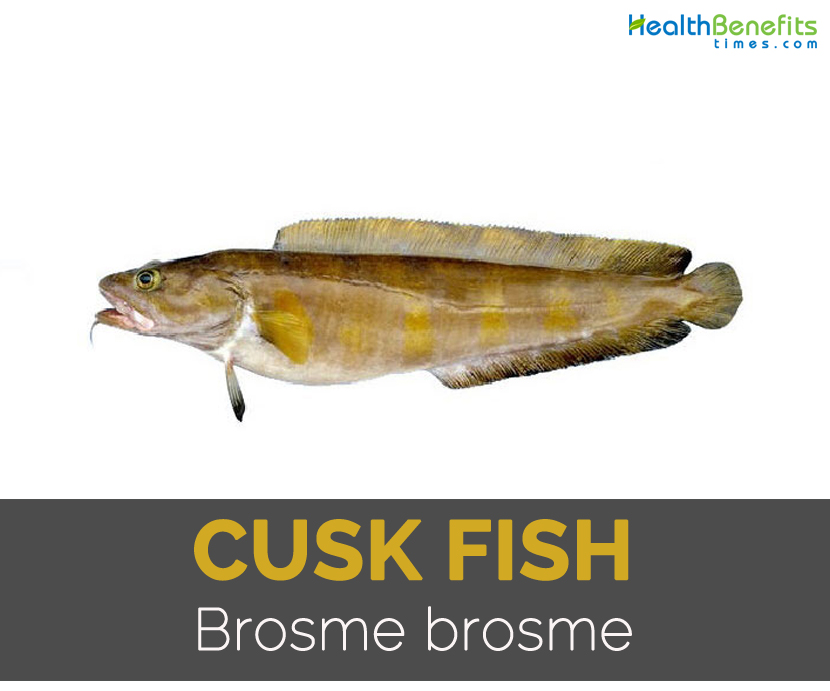| Cusk Fish Quick Facts | |
|---|---|
| Name: | Cusk Fish |
| Scientific Name: | Brosme brosme |
| Colors | Brownish grey above and paler underneath |
| Shapes | Elongate, taper shaped, 4 ft. (120 cm) |
| Flesh colors | Raw: White; Cooked: Opaque white |
| Calories | 106 Kcal./cup |
| Major nutrients | Selenium (80.91%) Isoleucine (63.82%) Lysine (63.64%) Tryptophan (59.09%) Threonine (57.73%) |
Having scientific name as Brosme Brosme, this fish has elongate body that measures 4 ft. (120 cm). Cusk fish has small head with downward sloping head and flat lower jaw. The barbell could be found on the chin. It has a flat dorsal fin that runs from in line having pectoral fin to tail and also a flat anal fin running from middle of the body to tail. Both are joined narrowly to small and rounded tail fin. Pelvic fin is mildly elongate. The curved lateral line is present in the middle. The color of cusk fish is variable most often above brownish grey and underneath is paler. Pale dorsal or anal fins acquire black band near margins with white rims. The specimens usually young have six transverse yellow bands on sides. The size of cusk may grow about 3 to 3.5 feet (90 to 110 cm) long. They live in deep water having little to no ambient light. It has large eyes and upturned for predator or prey detection. It has the lifespan of 20 years in wild.
Life cycle
During spawning season, females could lay up to 2 million buoyant eggs at a time. Eggs hatch into planktonic young that remains in coastal and shallow-water environments till they grow to 5 centimeters length. It has slow growth rate (on average reaches 22 centimeters by age 6 and then gains about 10 centimeters per year thereafter). When reached 50 cm long (8 to 10 years of age), they achieve sexual maturity.
Reproduction
Cusk are regarded to be polygynous and is solitary outside breeding season. Once in a year, spawning occurs between April and July. The spawning grounds throughout this species ranges with notable areas between Scotland and Iceland, in northern North Sea, along edges of Shetland and Faeroe Islands and In the Gulf of Maine.
Food
It is a bottom-dwelling species, sluggish and a weak swimmer. It consumes crustaceans and other soft bodied invertebrates or mollusks.
How to Eat
- It could be found fresh, dried salted and frozen as fillets.
- Cusk fish is often consumed steamed, boiled, fried, baked, broiled and microwaved.
- Being oilier, the meat of Cusk fish is baked and grilled.
- It is used in chowders and soups.
- It is also used in kabobs.
- The small pieces could be stir fried.
- The salted fillets could be boiled and used in different dishes.
References:
https://www.itis.gov/servlet/SingleRpt/SingleRpt?search_topic=TSN&search_value=164740#null
https://en.wikipedia.org/wiki/Cusk_(fish)
http://www.fao.org/fishery/species/2217/en
https://www.britannica.com/animal/cusk
https://www.seafoodsource.com/seafood-handbook/finfish/cusk
https://maineguides.com/maine-saltwater-fish-species/cusk/
https://fromnorway.com/learn-more/seafood-encyclopedia/tusk-cusk/
Comments
comments
